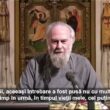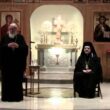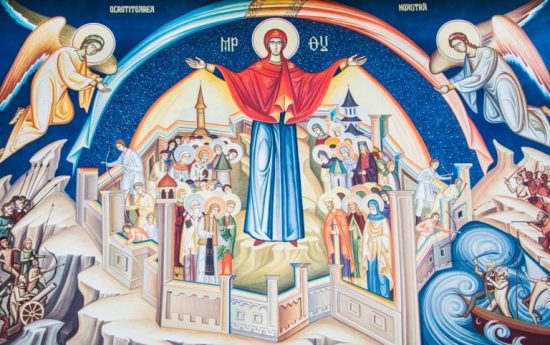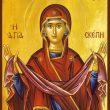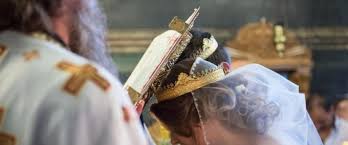Since ancient times, to the Most Holy Mother of God was given a special honor in the theology and cult of the Orthodox Church and a great appreciation and devotion from her believers. The hymnographs, theologians and all the Saints of our Church always dedicated to her troparia, chants, hymns and akathists, presenting in all these compositions nuances and dogmatic ideas or the numerous miracles the Holy Mother of God has been making until nowadays in the lives of those who have a great devotion towards Her and call her to their aid.
It is not a mere coincidence the fact that the beginning and the end of the church year are marked by two great feasts dedicated to the Holy Mother of God: August 15th and September 8th – The Dormition and Birth of the Holy Mother of God, October being marked as well from its very beginning by a feast which reminds us all about one of her miracles: The Day of the Protection of the Holy Mother of God
With this occasion we thought to collect before her feast a few facts which probably many of us don`t know about the glorious Feast of the Protection of the Holy Mother of God or until now we haven`t had the chance to find them among the uncountable miracles and testimonies dedicated to her
We invite you to read them in the lines from below :
1.The Feast of the Protection of the Holy Mother of God is settled by our Church in the remembrance of a miracle which took place on October 1st in the year 911 during the reign of emperor Leon the Wise. What happened then more exactly? During the vigil service which was taking place in the Holy Church of Blachernae from Constantinople, saint Andrew the Fool for Christ was staying withdrawn in a pew in the back of the Church near his disciple, Epiphanios. The chants gave the impression that the heaven descended on earth but what happened towards four o clock in the morning it was not an impression or an illusion: the Most Holy Mother of God appeared before all those who attended the holy service, standing in the air and keeping her veil stretched like a cover over the heads of the believers.
2.The writings of the Church presents us the spectacular image which appeared before the eyes of those who prayed at unison in the Church from Blachernae: they say the Holy Mother of God shone like the sun and covered the people with her holy veil, being accompanied by heavenly armies and a great number of Saints dressed in white clothes, two of them distinguishing themselves among the rest, Saint John the Baptist and Saint John the Evangelist. Full of emotion and wonder, Saint Andrew told his disciple, blessed Epiphanios: `My brother, do you see the Empress and Lady of all who prays for the whole world? And he said: I see her, honorable father and I marvel at seeing her covering the people who are present in the church with her holy veil which shines brighter than the sun.
3.From a historical point of view, according to the Chronicle of the old ages, a paper of a great value written around 1113 by Nestorius the chronicler, the inhabitants of Constantinople asked for the help of the Holy Mother of God to save them from an attack of the powerful fleet of the Russian led by Askold and Dir, fact which happened. According to the chronicle before the battle it took place a holy service which lasted for the whole night then the veil of the Holy Mother of God was sunken in the sea near the Church of Blachernae. No detail is mentioned about the presence of the Saints Andrew and Epiphanios or information relating to the miraculous apparition of the Most Holy Mother of God.
4.The classic icon of the Veil of the Holy Mother of God is a special one too: the Holy Mother of God is painted standing over the believers with her hands raised in prayer and covering with her veil the crowd of praying believers. Angels are painted on both her sides and on her right side appear Saint Andrew the Fool for Christ and his disciple, Epiphanios. Near them are painted the twelve Apostles, bishops, monks and holy martyrs and near the image of the Holy Mother of God is painted Saint Romanos the Melodist, who is celebrated on the same day of October 1st and he keeps in his hands a parchment where it is written the kontakion `The Virgin today`
5. The Holy Veil of the Holy Mother of God is known in the Slavic space under the name of Pokrov (in Russian Покров), which expresses the term with the same meaning of veil. The word is also known in the cult of the Church from the holy liturgy, pokrovich being a cult object which consists of a small square piece of cloth used for covering different cult items. In every holy altar we always find 3 items with this name: two small in the shape of the Holy Cross with equal arms used for the Holy Disk and the Holy Chalice and another bigger one of rectangular shape called air with which are covered both holy vessels.
Thus, keeping in mind what it was related, let us celebrate on this day of October 1st the Feast of the Veil of the Most Holy Virgin Mary, the Mother of God, remembering her wondrous apparition which took place in the Church of Blachernae. Let us thank to God like the pilgrims from Blachernae for the fact that we have the Holy Mother of God as intercessor for our salvation and let us not forget to call her in our prayers when we need the most her aid and mercy.
Source: http://blog.bizanticons.ro


